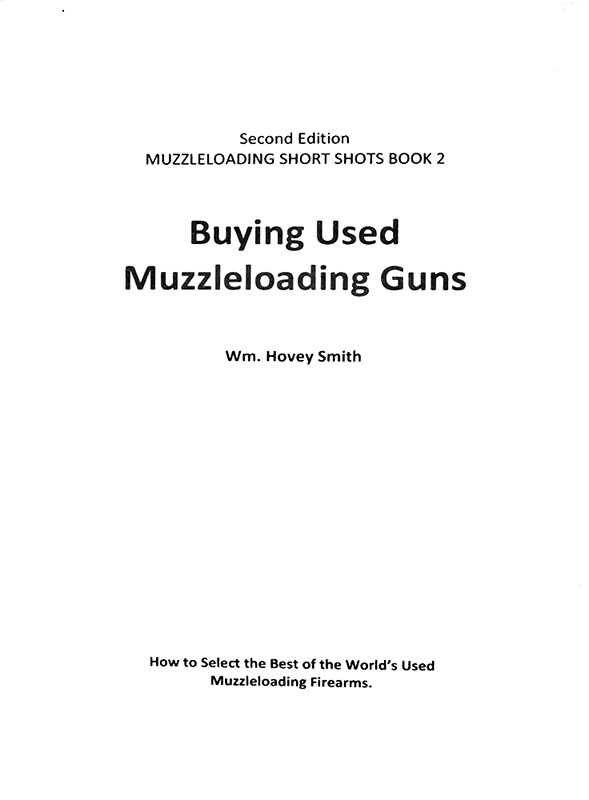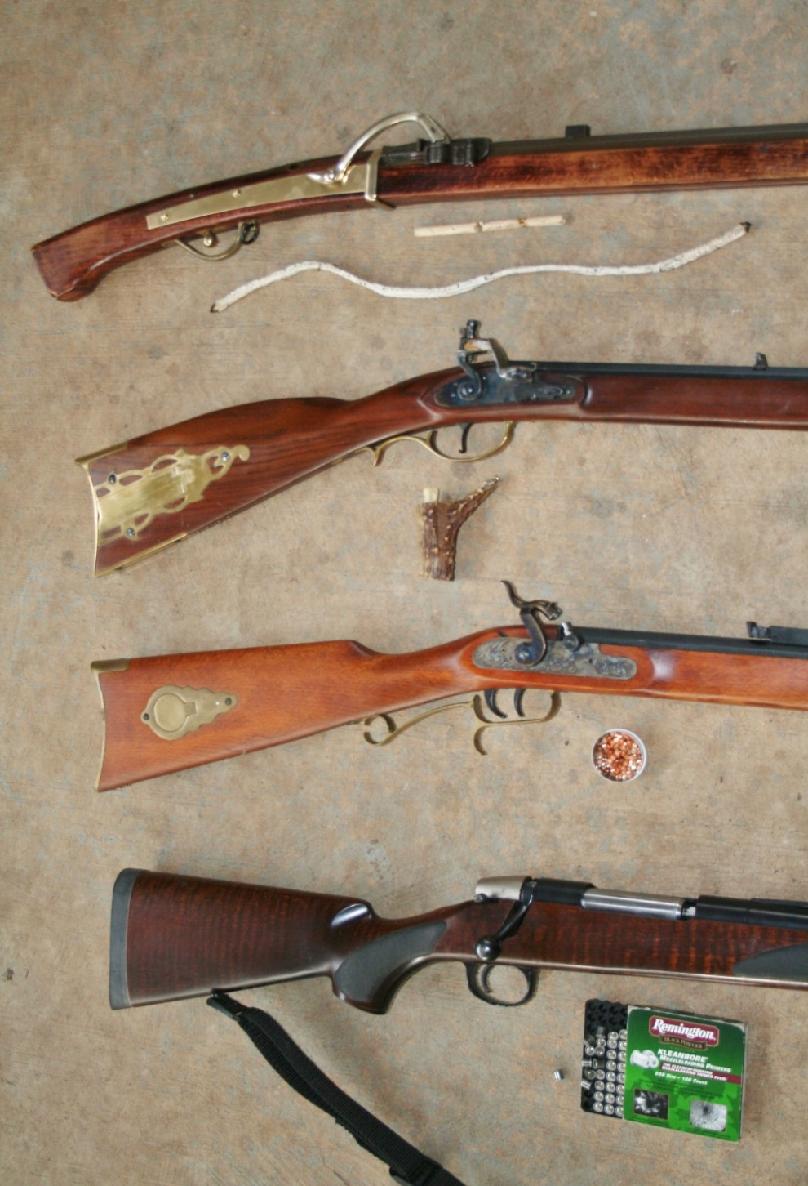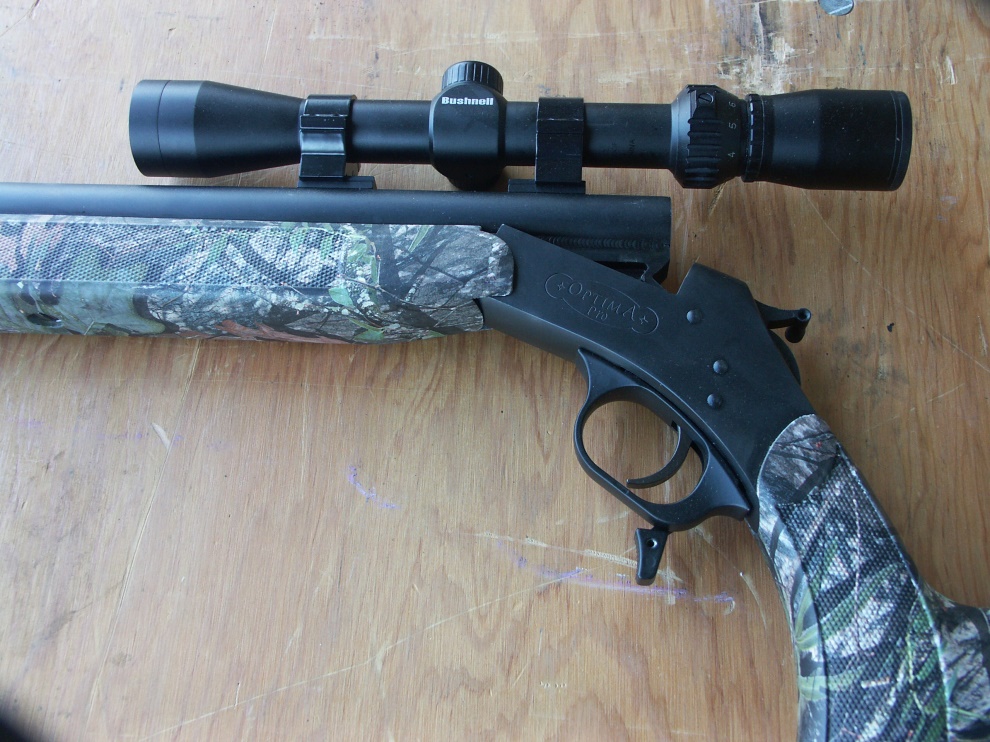


Whitehall Press – Budget Publications
Sandersville, Georgia
ISBN 978-0-916565-17-6
© Wm. Hovey Smith, 2020, Any reproduction of all or parts of this work are prohibited and punishable under U.S. and international copyright laws, except that brief passages may be quoted in reviews. This copyright includes all original images and derivative works.

Ignition systems for muzzleloading guns. From the top, matchlock, flintlock, percussion, and in-line ignitions.
Introduction
Books in the Muzzleloading Short Shots series were developed to give black-powder gun enthusiasts information in tightly-focused packages. Each book contains candid comments about guns, powders, bullets, ignition systems, and hunting techniques.
These brief treatments are based on 50 years of shooting and hunting with these guns. I started writing for the outdoor press in the 1970s in The American Rifleman and sold articles to many other publications. I was the Corresponding Editor for the Gun Digest Annual for 10 years covering muzzleloading guns, products, and hunting. Each editor has his own slant about the topic that he covers, and my principal interest was on hunting with muzzleloading guns .
In addition to the articles, I have some 20 other books and e-books that include Practical Bowfishing, Crossbow Hunting, Backyard Deer Hunting: Converting Deer to Dinner for Pennies per Pound, and X-Treme Muzzleloading: Fur, Fowl, and Dangerous Game with Muzzleloading Rifles, Smoothbores, and Pistols. All of the above are now available in both softcover and as e-books. This e-book series consists of eight titles of which six have been published. The published books in the series are: Muzzleloaders for Hunters, Shooting and Maintaining Your Muzzleloader, Hunting with Muzzleloading Shotguns and Smoothbore Muskets, Hunting with Muzzleloading Pistols, and Hunting with Muzzleloading Revolvers. These books are all available from on-line booksellers. The two remaining titles in the series are one on building and restoring muzzleloaders and the other about using muzzleloading guns for self-defense.
Some of my other books that are not directly related to firearms discuss or promote outdoor lifestyles and activities including my business books, Create Your Own Job Security : Plan to Start Your Own Business at Midlife, and Make Your Own Job: Anytime, Anywhere, At Any Age which will be published in 2020.
Yet more outdoor-related materials are found on my now-discontinued, but still available Podcast Radio Show, Hovey’s Outdoor Adventures, which is on WebTalkRadio.net, and some 800 YouTube videos on the Hovey Smith Channel. My novel in progress is Father of the Grooms which is now available as a First Draft edition e-book. There will be a later soft-over edition of this book and perhaps a movie under the title Murder, Marriage, and Mafia: An American Family Meets Their Sicilian Cousins.
I have made an attempt to check the present resale price of the firearms that I describe. Generally these do generally increase over time, but may vary considerably depending on the condition of the firearm. The prices given should be considered only as general guidelines.
Loads listed in this series of book were safe and effective in the guns that I used under the conditions that I used them, but I cannot take responsibility for loads assembled by others. Use only black powder or black powder substitutes in these guns and loads that are recommended by the manufacturer. Any loads given should be used only in newly manufactured guns in good condition – be prudent, be safe, and good hunting.
Chapter 1.
Buying Used Black-Powder Rifles

CVA Optima break-barrel muzzleloading rifle
Numbers of modern replica muzzleloading rifles are appearing on used gun racks at local shops as hunters are aging out of the sport. Are these good buys? As with all such things, it depends. Questions might be, “What do I need this gun for?” An honest, but not often expressed, question might be “This is a unique gun, and I sort of like it; but do I really want to own it?” A gun seller will make every argument that he can think of as to why you should buy it, and maybe you will be strong and resist and maybe not.
But outside of need or desire, how do you decide if that a particular muzzleloader is worth buying. Things like a battered nipple or lost front sight can be easily replaced. However the barrel is the most significant thing about your muzzleloader that cannot be cheaply replaced, and it should be examined first.
Barrels
Barrels are the soul of a gun. Without a good barrel, attractive wood, finishing, and furnishings are so much window dressing. If the barrel is still sharp at the crown, not pitted, and a tightly fitted patch goes in and out smoothly, the gun may be a keeper.
Make sure the gun is uncapped or, if a flintlock, that the frizzen is in the forward position. Put a lightly-lubricated patch on the ramrod’s jag, and push it down the bore using slow, even pressure. If the patch goes down without catching or encountering loose spots, this is a good sign.
When the ramrod is all the way down, put a piece of tape on it at the muzzle to mark its furthest point of progress. Pull the ramrod, and again feel for tight and loose spots that might indicate eroded sections of the barrel or a ringed barrel cause by shooting the gun with an obstructed bore.
If patches seem to catch within 3/8ths of an inch in front of the breech plug this is acceptable. As a production expedient, threading for the breech plug often exceeds the length of the breech plug’s threads so that the threaded portion of the breech occupies a portion of the powder chamber. While not desirable, this is common. These barrels are safe and will shoot fine.
Lay the ramrod on top of the barrel with the tape at the end of the muzzle. If the ramrod did not go to the bottom of the barrel, then there is something, maybe a live charge, in the gun. If you find something, report this to the shop owner, and let him deal with the problem. Only after he has cleared the barrel, should your examination of the gun continue.
Many muzzleloaders, past and present, have been put up with charges in their barrels. In an inspection of the NRA’s gun collection nearly 30 percent of their muzzleloading guns were found to be loaded. This condition was so common in the day that Mark Twain had a running joke about how a kid playing with an old family gun had shot his grandmother. That old relic on the wall may not be as safe as you suppose.
Now that you have the patch out of the barrel examine it. If the patch is clean, then the gun is fine. If the patch is covered with rust, this means that the barrel steel is oxidizing. This may not be a fatal defect. If another patch slides smoothly up and down the bore and comes out with only a light rust stain, that means that any rust pitting is very shallow and the gun will shoot well, despite the slight pitting. The color of the patch is less important than the condition of the bore. If the bore is so rough that the patch seems to hang up and comes out with torn places, then the gun should be rejected. A patch that comes out dirty can often be used to negotiate a lower price for the gun.
If the interior of the barrel seems acceptable run your finger down the exterior of the barrel and feel for bulges. The finger can detect a few thousands of an inch difference in the barrel contour. If the barrel passes these tests, now is the time to examine the lock.
Locks
With hammer guns most locks should have three positions. The first is down on the nipple, although more modern rebounding hammer locks will have the hammer at rest slightly above the nipple face. The second position in for half-cock, although that position may be eliminated on target guns. The third position is with the hammer fully cocked and all the way back to the rear. The hammer will pull back to disengage the sear from the tumbler, but should lock solidly when the sear falls into the hammer notch. You may be able to wiggle the hammer sideways by a small amount in original muzzleloaders that have seen a lot of wear, but the sear should still be solidly retained in the hammer notch.
Ideally, the hammer should come back smoothly, but even some new guns from respected makers may have rough-feeling locks. Thirty-minutes of careful work with a stone will usually cure this problem.
If the lock feels good, take a fitted screwdriver and remove it. The interior parts of the lock should be clean and bright with perhaps a bit of light discoloration. If parts show rust, this means that the previous owner did not clean the lock after shooting the gun. Often the first parts to show serious rust damage are small springs. These may be weakened to the point that revolver mechanisms no longer function and there is insufficient pressure on the hammer for it to readily go into full cock.
Provided that the edges of the sear are sharp and the hammer notches are not chipped, some surface rust is, again, not a fatal flaw. This rust is another bargaining point for a lower price on the gun. I often use a 10-power hand magnifier to enable these tiny contact services to be closely inspected.
In-line rifles are easy to examine. Make sure there is no cap or primer on the nipple, and check that the safety/s is/are working properly. The barrel can be dropped or the bolt removed which will expose the breech plug. In the majority of modern guns the plug may be removed, but sometimes this requires the use of a wrench or vice. Once this is done the barrel can be examined by looking through it at a light source or by shining a flashlight down the muzzle while it is resting on a table.